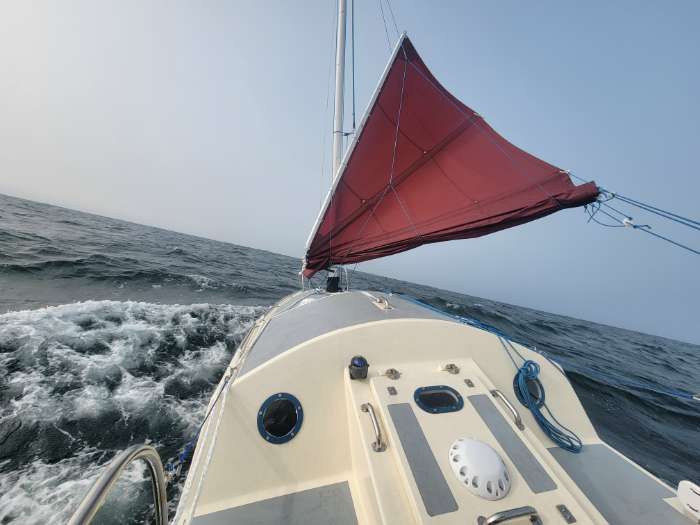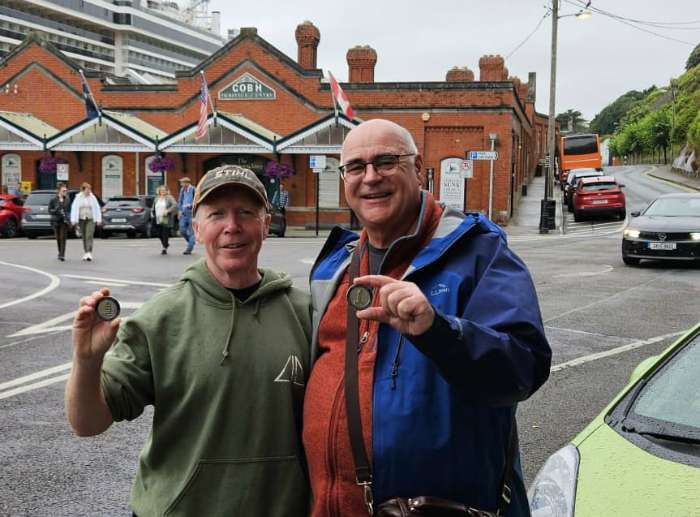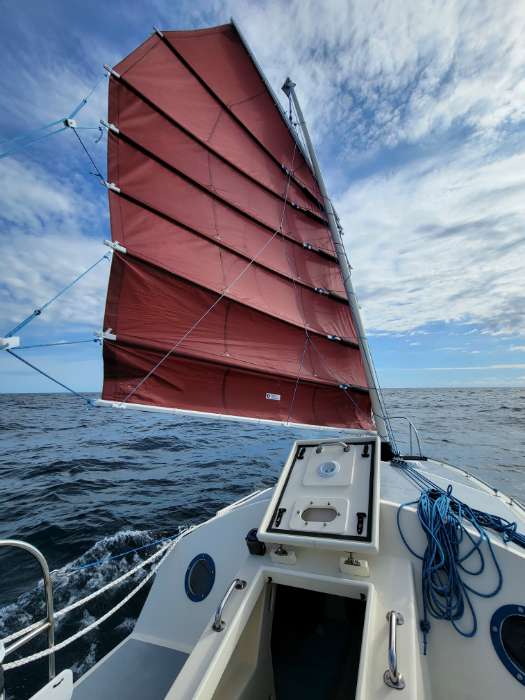A Sailing Journey on a 21-Foot Junk Rig Sailboat
Last spring I chronicled Alan Mulholland’s quest to sail a sailboat of his own design and construction singlehanded from his home in Canada’s Prince Edward Island to Ireland, the country of his birth.
At that time, Mulholland and his tiny craft were holed up in Baltimore awaiting a weather window that would allow the veteran ocean voyager to hopscotch down the US Coast, eventually landing in Norfolk for a bit of refit prior to jumping off for the Azores in mid-June with a subsequent 39-day passage planned to Ireland in early July.

Headed south and east, Mulholland eventually found his way to Eastport’s sailor’s bar in Annapolis, The Boatyard Bar and Grill.
Mulholland and I shared some mussels and crab cakes as he detailed the next leg of his voyage. Readers interested in the specifics of Mulholland’s tiny boat, Wave Rover, and the story of his build may click here.
Fast forward three months and we find Alan and Wave Rover enjoying Irish hospitality at its finest as he and his home-built craft cruise along Ireland’s picturesque coast.
From Virginia to Ireland
The Prince Edward Islander has just completed a 3400 nautical mile voyage from Norfolk, Virginia, to Baltimore, Ireland in a period of 39 days. Mulholland’s solo voyage in the little boat he has dubbed the Wave Rover is his fourth ocean crossing. His motto is: Forge your own adventure.
What made this crossing special was the performance of Wave Rover in tough mid-Atlantic conditions that tested man and machine to the ultimate. During parts of the passage Mulholland braved 35- to 40-knot winds and 10-15-foot seas. His only contact with other boats was an encounter with a fleet of IMOCA 60s racing from New York to Les Sables, France, at 17 knots.
Mulholland reports having a pleasant VHF conversation with one skipper as they passed within 100 yards. “The skipper was amazed to see a little boat like mine way out in the open ocean. It was eye opening for him, and a chance for me to see another boat was reassuring.”
Mulholland summarized his voyage: “Despite each crossing being unique, I have never felt so relaxed and refreshed. Were it not for the electrical system repairs needed after the first week, I felt as though I could have departed the Azores a day after arriving due to feeling very relaxed and well-rested.”

Rough Weather Happens
Some parts of the crossing were nail biting, but the veteran ocean cruiser took the rough weather in stride.
“I never felt in peril, although the 45-knot winds and large seas caused an electrical failure and ripped off the aluminum radar reflector from the mast. The rest of the boat remained undamaged. Having built her robustly, I felt very secure when she was fully reefed and the hatch was dogged shut.”
Wave Rover clipped along at about five or six knots, dancing over the waves and providing a pleasant rocking motion for Alan. He was able to average 120 nautical miles per day when the winds were favorable (10-20 knots). His fuel usage was minimal.
“I did not use the motor except for the first and last two or three nautical miles of each leg. I started from Virginia Beach with 10 gallons of fuel for my 6-hp outboard and arrived in Ireland with approximately nine gallons remaining.”
Mulholland’s dream of a long-distance voyage in a boat of his own design and construction is not a unique one. Many a sailor has dreamed of fulfilling a bucket-list trip like his.
But few could imagine going across the Atlantic in a tiny 21-foot-long , 3000-pound twin-keel home-built sailboat powered by a 230-square foot junk-rig sail with a whopping 6-hp auxiliary motor for back-up propulsion.
“Heck,” the self-effacing carpenter turned boatbuilder said, “the boat is solid, but we shaved costs wherever we could… like building the mast out of regular lumberyard 2x6’s.”
A Purpose-Built Boat
For Mulholland, the most important part of his sailing adventure is not the journey itself, what he may accomplish at sea, or even if he accomplishes his goal. Instead, it’s about reaching his potential and pushing himself.
The Wave Rover was purpose-built to carry a solo sailor across the Atlantic and back.
“The boat had to be strong enough to cross the Atlantic. She needed to have sufficient capacity to carry 90 days of supplies yet be light enough to be propelled by a 6 hp motor. Most of all, she had to be comfortable at sea with a rig that was easy to control and repair.”
Mulholland selected the “junk” rig because it was simple, easy to build and reef. In tests, the rig performs well off the wind, although Mulholland figures she can go 50-55 degrees to windward which, they say, is a reasonable amount for a small, light boat.
The mast, which projects 21 feet from the deck, is unstayed, “but strong enough to withstand excessive loads.”
Her 230-square-foot junk rig can be depowered in seconds all from the safety of the cockpit. When reefed, the center of effort of the sail stays the same as panels of sail are folded on top of one another.

A Voyage With an Audience
Just like the boat itself, communications and navigation are simple: Mulholland relies on two “cheap” tablets and a newish cell phone to run his Navionics navigation program. He sends and receives text messages underway via a Garmin In-Reach communicator; he keeps aware of other boats with an active AIS system “that drives me crazy when we are in a busy shipping lane.”
Even though this trip is touted as a “solo” voyage, thanks to a robust YouTube audience of over 44,000 followers, Mulholland will hardly be alone. The sailor turned YouTube celebrity plans to upload a number of videos chronicling his voyage.
Mulholland has already produced over 240 episodes for the social network channel detailing the design and build of his unique craft.
Mulholland was able to do extensive filming during the voyage. As a result, his subscriber count has nearly doubled every week, now exceeding 44,000. Of the posts, he says “I have changed the video style to highlight the realities of sailing on a small boat and to share my reflections while enjoying the solitude of the ocean.” Go to : https://www.youtube.com/watch?v=y8b-EvPW-Z4 for a taste of Mulholland’s Atlantic crossing.
In one of his posts, Mulholland sums up Wave Rover: “The Wave Rover is a fast, safe, self-righting, easy-to-build, easy-to-sail boat that went from concept to reality over a period of 24 months.” Plans for do-it-yourselfers will be made available just in time for Christmas this year.

“I’m not into records,” says Mulholland. “I want to enjoy the experience, share my adventures with my YouTubers, meet some interesting people, and live to tell about it.”
The intrepid adventurer plans to sail to Dublin, stopping at various ports along the way, and to winter Wave Rover in the Dublin area. His wife will join him along the way.
Will Mulholland continue with his journey around the world in his little boat?
“Hard to say,” he concludes. “Tune into my YouTube channel for updates.”
By Craig Ligibel
Find more cruising adventure stories here.




